BSTA001 Business Statistics: Analyzing Life Satisfaction Factors
VerifiedAdded on 2023/03/30
|8
|1181
|92
Report
AI Summary
This report summarizes data on life satisfaction and socio-economic factors, based on a sample size of approximately 60. Statistical analysis, including histograms, hypothesis testing, and scatter plots, reveals that individuals with high life satisfaction are more likely to be highly satisfied with their health. The findings indicate insufficient evidence to establish a definitive relationship between life satisfaction and socio-economic factors. Regression analysis identifies financial satisfaction as a potentially significant predictor of life satisfaction, although further investigation is warranted. Hypothesis testing supports the conclusion that individuals with higher life satisfaction are more likely to report higher health satisfaction. A chi-square test suggests no significant relationship between life satisfaction levels and socio-economic factors within the target population. The report concludes by emphasizing the need for further research incorporating additional variables to enhance the predictive power of the regression model. Desklib provides access to similar solved assignments and resources for students.
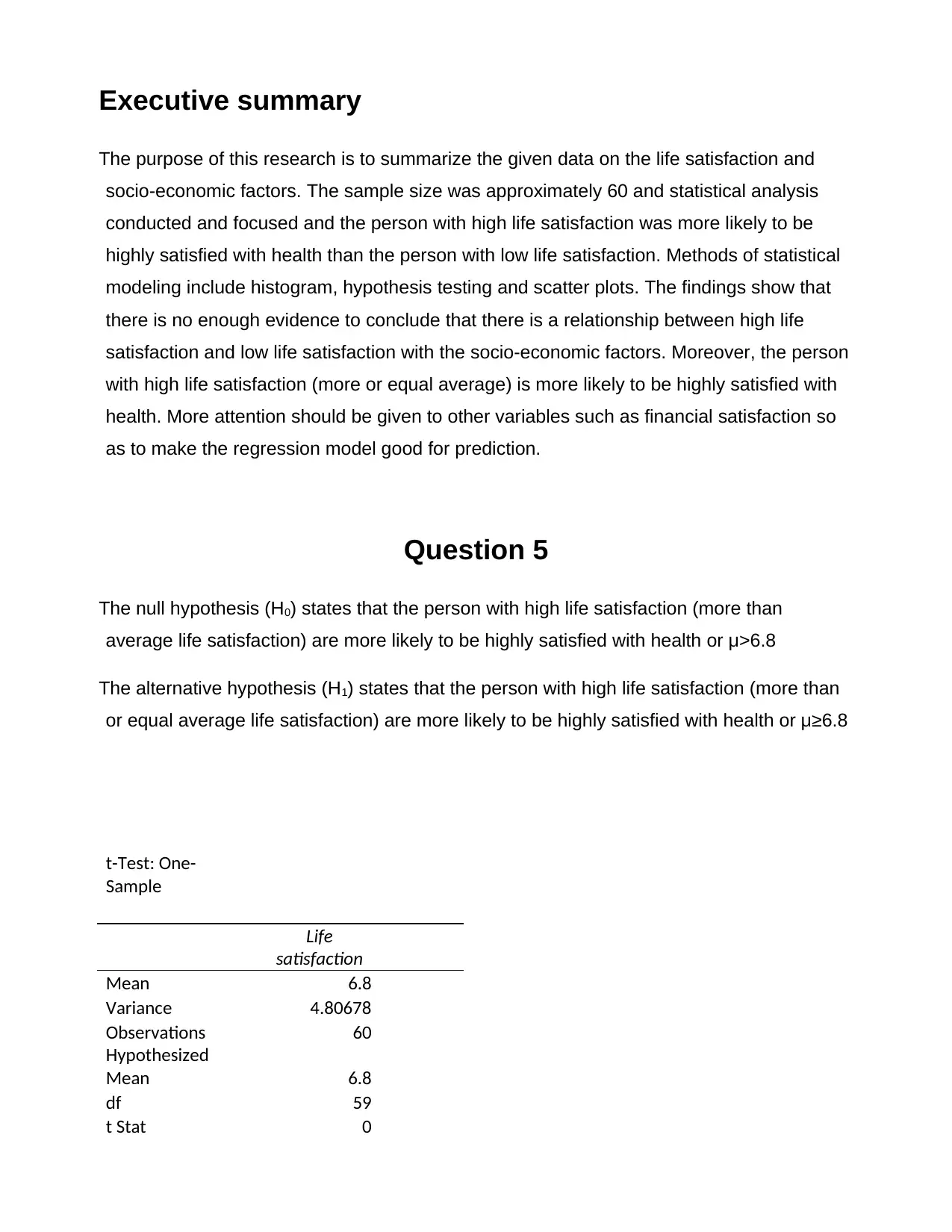
Executive summary
The purpose of this research is to summarize the given data on the life satisfaction and
socio-economic factors. The sample size was approximately 60 and statistical analysis
conducted and focused and the person with high life satisfaction was more likely to be
highly satisfied with health than the person with low life satisfaction. Methods of statistical
modeling include histogram, hypothesis testing and scatter plots. The findings show that
there is no enough evidence to conclude that there is a relationship between high life
satisfaction and low life satisfaction with the socio-economic factors. Moreover, the person
with high life satisfaction (more or equal average) is more likely to be highly satisfied with
health. More attention should be given to other variables such as financial satisfaction so
as to make the regression model good for prediction.
Question 5
The null hypothesis (H0) states that the person with high life satisfaction (more than
average life satisfaction) are more likely to be highly satisfied with health or μ>6.8
The alternative hypothesis (H1) states that the person with high life satisfaction (more than
or equal average life satisfaction) are more likely to be highly satisfied with health or μ≥6.8
t-Test: One-
Sample
Life
satisfaction
Mean 6.8
Variance 4.80678
Observations 60
Hypothesized
Mean 6.8
df 59
t Stat 0
The purpose of this research is to summarize the given data on the life satisfaction and
socio-economic factors. The sample size was approximately 60 and statistical analysis
conducted and focused and the person with high life satisfaction was more likely to be
highly satisfied with health than the person with low life satisfaction. Methods of statistical
modeling include histogram, hypothesis testing and scatter plots. The findings show that
there is no enough evidence to conclude that there is a relationship between high life
satisfaction and low life satisfaction with the socio-economic factors. Moreover, the person
with high life satisfaction (more or equal average) is more likely to be highly satisfied with
health. More attention should be given to other variables such as financial satisfaction so
as to make the regression model good for prediction.
Question 5
The null hypothesis (H0) states that the person with high life satisfaction (more than
average life satisfaction) are more likely to be highly satisfied with health or μ>6.8
The alternative hypothesis (H1) states that the person with high life satisfaction (more than
or equal average life satisfaction) are more likely to be highly satisfied with health or μ≥6.8
t-Test: One-
Sample
Life
satisfaction
Mean 6.8
Variance 4.80678
Observations 60
Hypothesized
Mean 6.8
df 59
t Stat 0
Paraphrase This Document
Need a fresh take? Get an instant paraphrase of this document with our AI Paraphraser
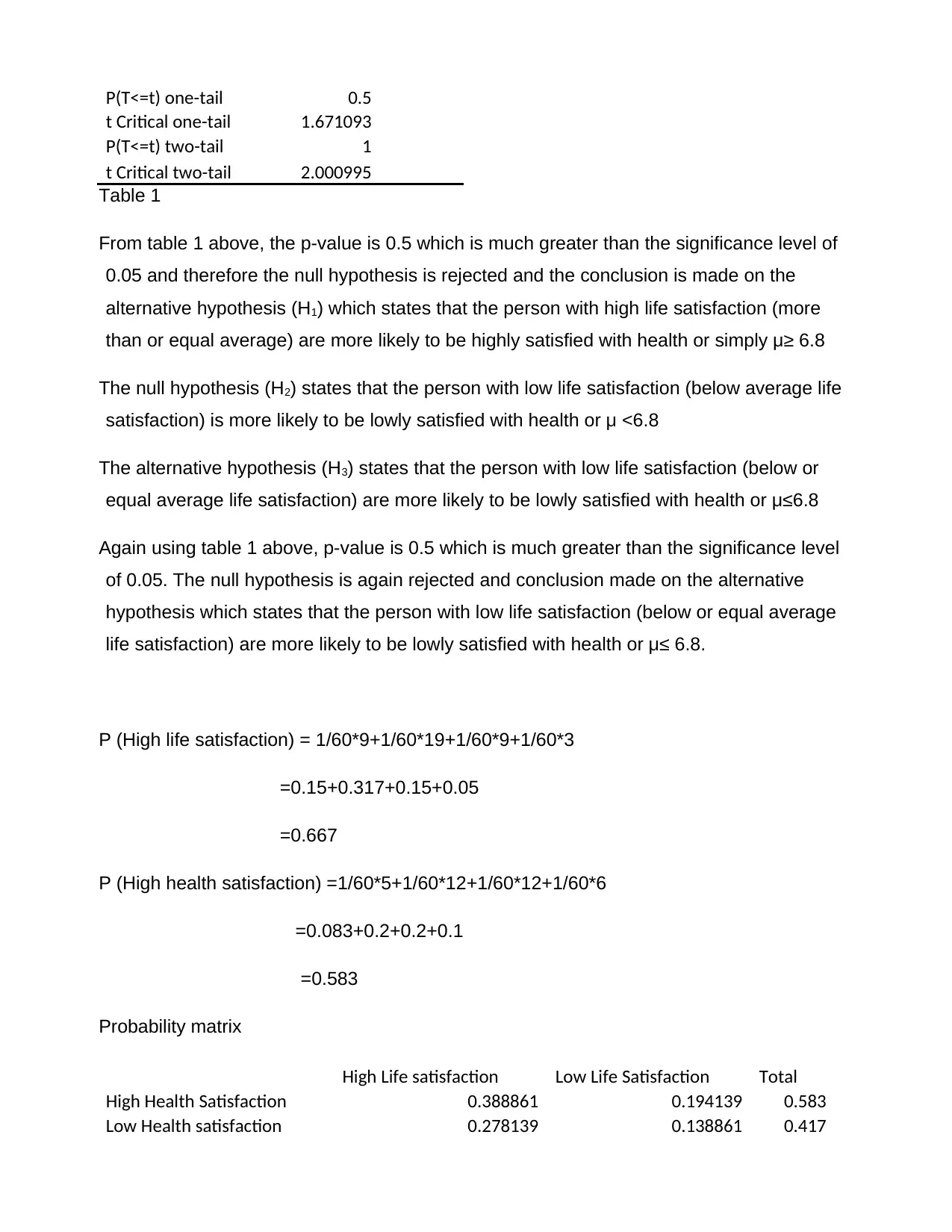
P(T<=t) one-tail 0.5
t Critical one-tail 1.671093
P(T<=t) two-tail 1
t Critical two-tail 2.000995
Table 1
From table 1 above, the p-value is 0.5 which is much greater than the significance level of
0.05 and therefore the null hypothesis is rejected and the conclusion is made on the
alternative hypothesis (H1) which states that the person with high life satisfaction (more
than or equal average) are more likely to be highly satisfied with health or simply μ≥ 6.8
The null hypothesis (H2) states that the person with low life satisfaction (below average life
satisfaction) is more likely to be lowly satisfied with health or μ <6.8
The alternative hypothesis (H3) states that the person with low life satisfaction (below or
equal average life satisfaction) are more likely to be lowly satisfied with health or μ≤6.8
Again using table 1 above, p-value is 0.5 which is much greater than the significance level
of 0.05. The null hypothesis is again rejected and conclusion made on the alternative
hypothesis which states that the person with low life satisfaction (below or equal average
life satisfaction) are more likely to be lowly satisfied with health or μ≤ 6.8.
P (High life satisfaction) = 1/60*9+1/60*19+1/60*9+1/60*3
=0.15+0.317+0.15+0.05
=0.667
P (High health satisfaction) =1/60*5+1/60*12+1/60*12+1/60*6
=0.083+0.2+0.2+0.1
=0.583
Probability matrix
High Life satisfaction Low Life Satisfaction Total
High Health Satisfaction 0.388861 0.194139 0.583
Low Health satisfaction 0.278139 0.138861 0.417
t Critical one-tail 1.671093
P(T<=t) two-tail 1
t Critical two-tail 2.000995
Table 1
From table 1 above, the p-value is 0.5 which is much greater than the significance level of
0.05 and therefore the null hypothesis is rejected and the conclusion is made on the
alternative hypothesis (H1) which states that the person with high life satisfaction (more
than or equal average) are more likely to be highly satisfied with health or simply μ≥ 6.8
The null hypothesis (H2) states that the person with low life satisfaction (below average life
satisfaction) is more likely to be lowly satisfied with health or μ <6.8
The alternative hypothesis (H3) states that the person with low life satisfaction (below or
equal average life satisfaction) are more likely to be lowly satisfied with health or μ≤6.8
Again using table 1 above, p-value is 0.5 which is much greater than the significance level
of 0.05. The null hypothesis is again rejected and conclusion made on the alternative
hypothesis which states that the person with low life satisfaction (below or equal average
life satisfaction) are more likely to be lowly satisfied with health or μ≤ 6.8.
P (High life satisfaction) = 1/60*9+1/60*19+1/60*9+1/60*3
=0.15+0.317+0.15+0.05
=0.667
P (High health satisfaction) =1/60*5+1/60*12+1/60*12+1/60*6
=0.083+0.2+0.2+0.1
=0.583
Probability matrix
High Life satisfaction Low Life Satisfaction Total
High Health Satisfaction 0.388861 0.194139 0.583
Low Health satisfaction 0.278139 0.138861 0.417
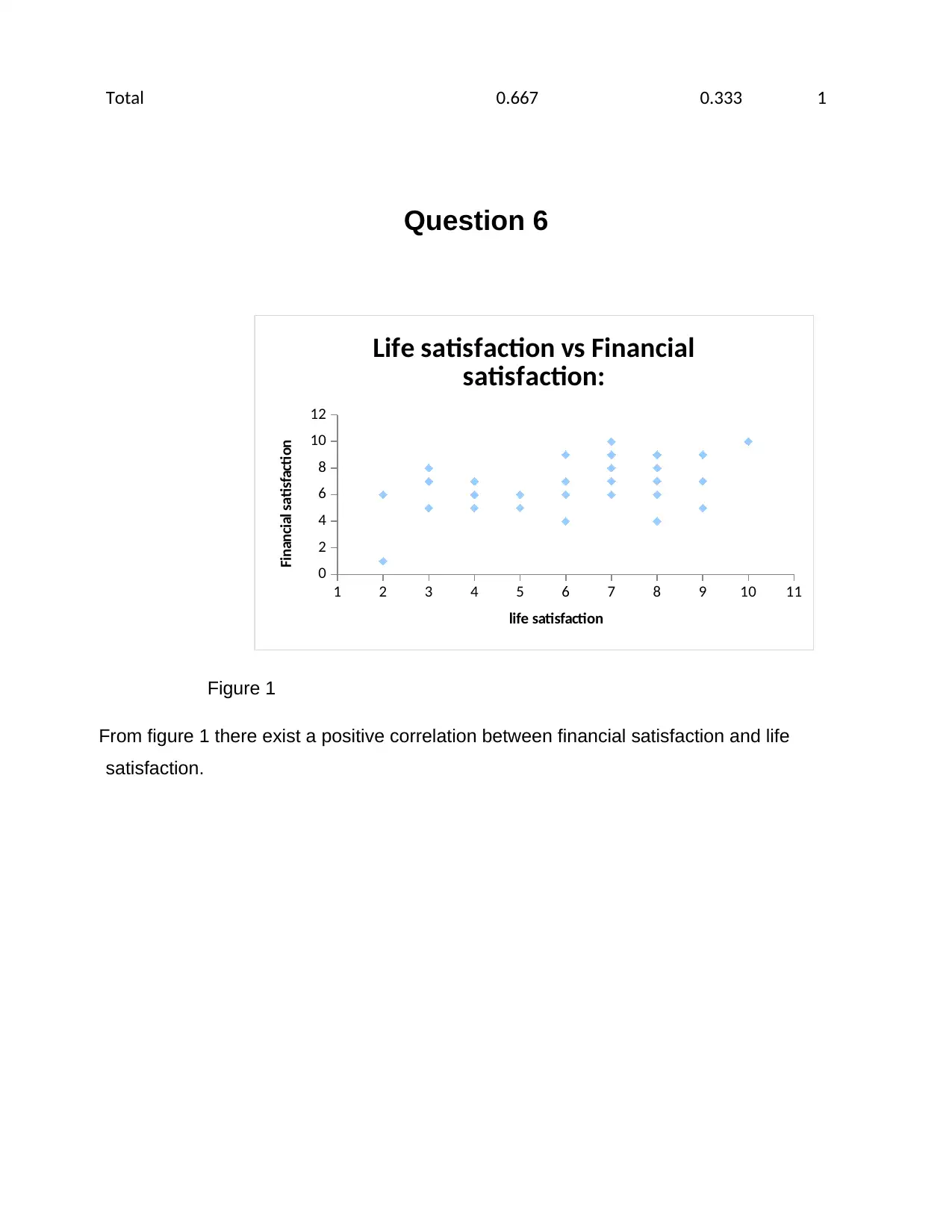
Total 0.667 0.333 1
Question 6
1 2 3 4 5 6 7 8 9 10 11
0
2
4
6
8
10
12
Life satisfaction vs Financial
satisfaction:
life satisfaction
Financial satisfaction
Figure 1
From figure 1 there exist a positive correlation between financial satisfaction and life
satisfaction.
Question 6
1 2 3 4 5 6 7 8 9 10 11
0
2
4
6
8
10
12
Life satisfaction vs Financial
satisfaction:
life satisfaction
Financial satisfaction
Figure 1
From figure 1 there exist a positive correlation between financial satisfaction and life
satisfaction.
⊘ This is a preview!⊘
Do you want full access?
Subscribe today to unlock all pages.

Trusted by 1+ million students worldwide
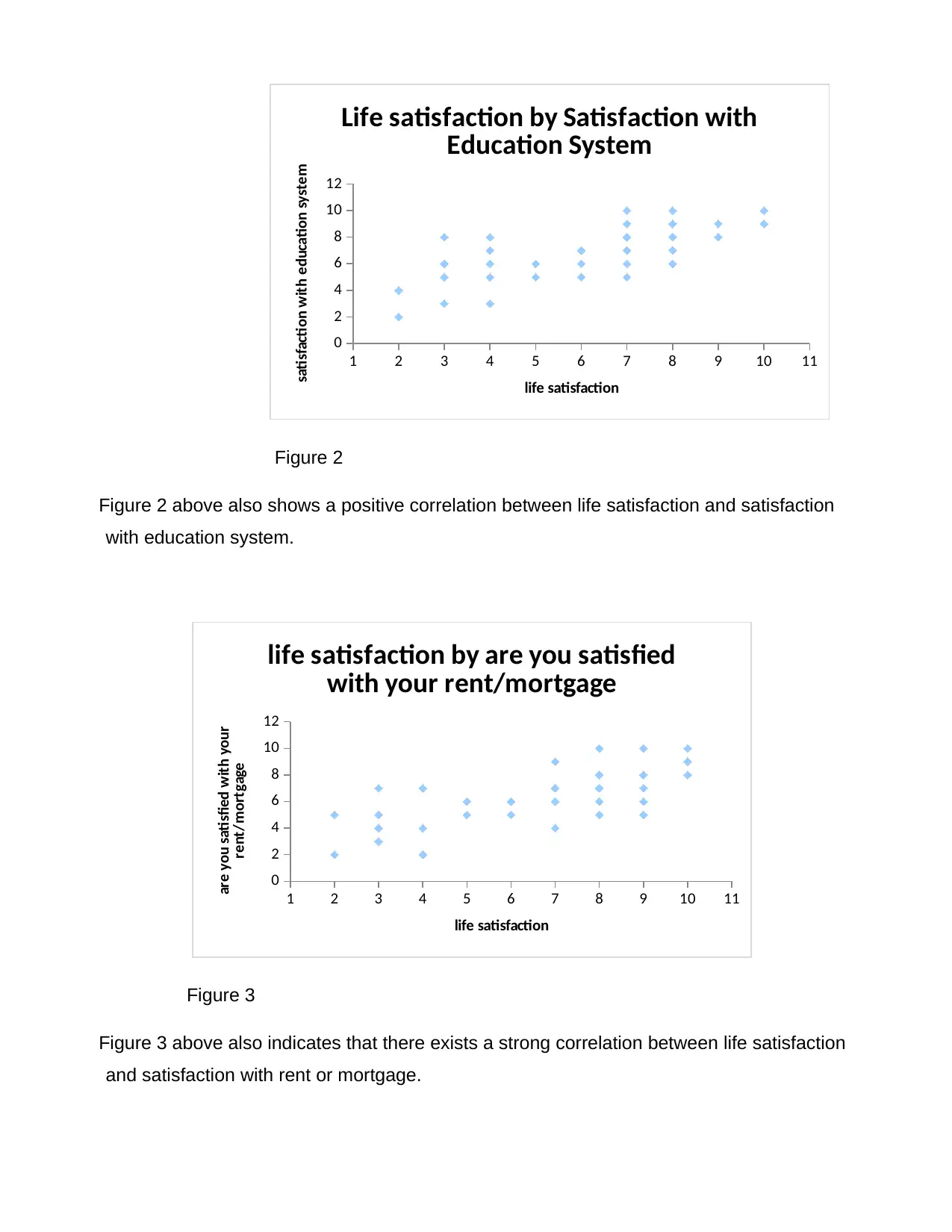
1 2 3 4 5 6 7 8 9 10 11
0
2
4
6
8
10
12
Life satisfaction by Satisfaction with
Education System
life satisfaction
satisfaction with education system
Figure 2
Figure 2 above also shows a positive correlation between life satisfaction and satisfaction
with education system.
1 2 3 4 5 6 7 8 9 10 11
0
2
4
6
8
10
12
life satisfaction by are you satisfied
with your rent/mortgage
life satisfaction
are you satisfied with your
rent/mortgage
Figure 3
Figure 3 above also indicates that there exists a strong correlation between life satisfaction
and satisfaction with rent or mortgage.
0
2
4
6
8
10
12
Life satisfaction by Satisfaction with
Education System
life satisfaction
satisfaction with education system
Figure 2
Figure 2 above also shows a positive correlation between life satisfaction and satisfaction
with education system.
1 2 3 4 5 6 7 8 9 10 11
0
2
4
6
8
10
12
life satisfaction by are you satisfied
with your rent/mortgage
life satisfaction
are you satisfied with your
rent/mortgage
Figure 3
Figure 3 above also indicates that there exists a strong correlation between life satisfaction
and satisfaction with rent or mortgage.
Paraphrase This Document
Need a fresh take? Get an instant paraphrase of this document with our AI Paraphraser
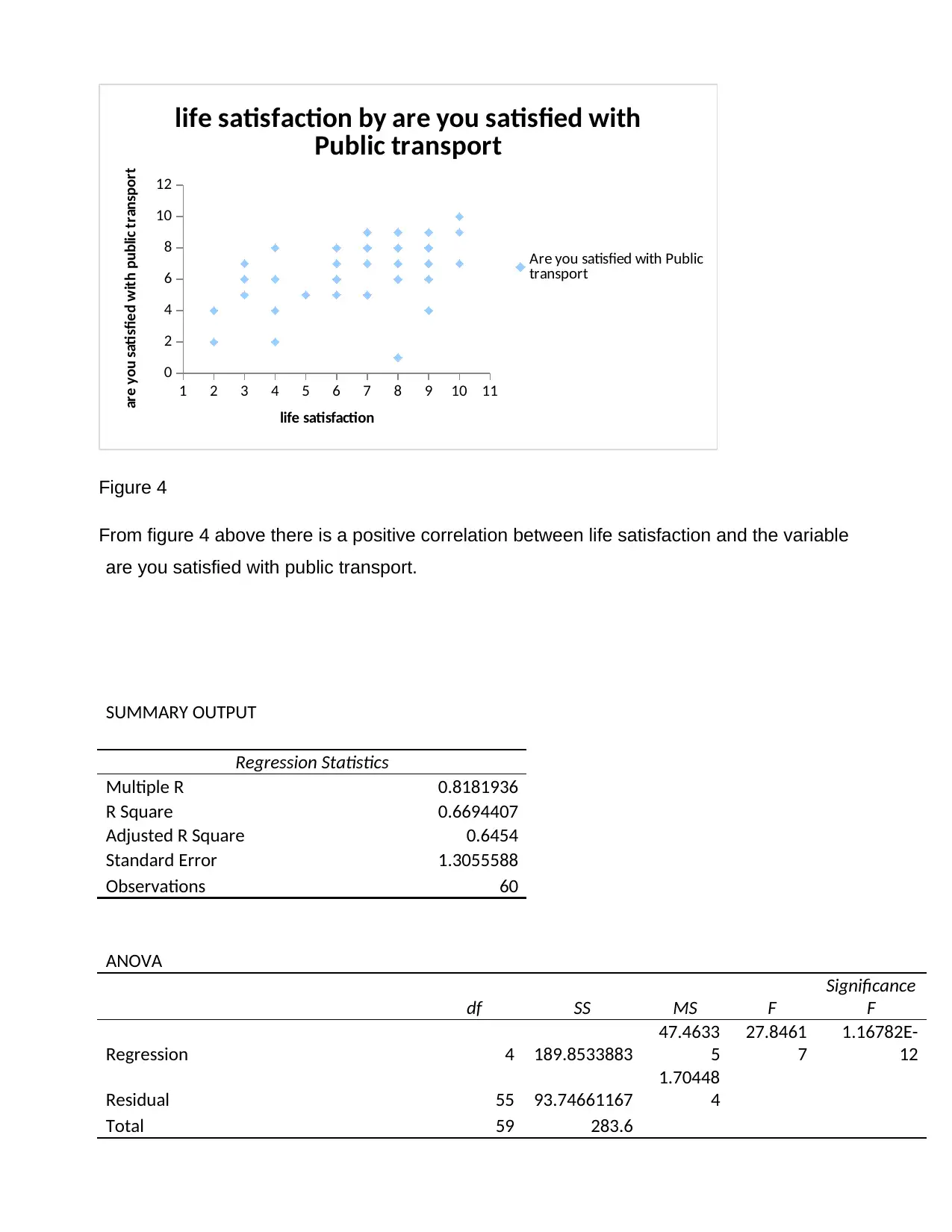
1 2 3 4 5 6 7 8 9 10 11
0
2
4
6
8
10
12
life satisfaction by are you satisfied with
Public transport
Are you satisfied with Public
transport
life satisfaction
are you satisfied with public transport
Figure 4
From figure 4 above there is a positive correlation between life satisfaction and the variable
are you satisfied with public transport.
SUMMARY OUTPUT
Regression Statistics
Multiple R 0.8181936
R Square 0.6694407
Adjusted R Square 0.6454
Standard Error 1.3055588
Observations 60
ANOVA
df SS MS F
Significance
F
Regression 4 189.8533883
47.4633
5
27.8461
7
1.16782E-
12
Residual 55 93.74661167
1.70448
4
Total 59 283.6
0
2
4
6
8
10
12
life satisfaction by are you satisfied with
Public transport
Are you satisfied with Public
transport
life satisfaction
are you satisfied with public transport
Figure 4
From figure 4 above there is a positive correlation between life satisfaction and the variable
are you satisfied with public transport.
SUMMARY OUTPUT
Regression Statistics
Multiple R 0.8181936
R Square 0.6694407
Adjusted R Square 0.6454
Standard Error 1.3055588
Observations 60
ANOVA
df SS MS F
Significance
F
Regression 4 189.8533883
47.4633
5
27.8461
7
1.16782E-
12
Residual 55 93.74661167
1.70448
4
Total 59 283.6
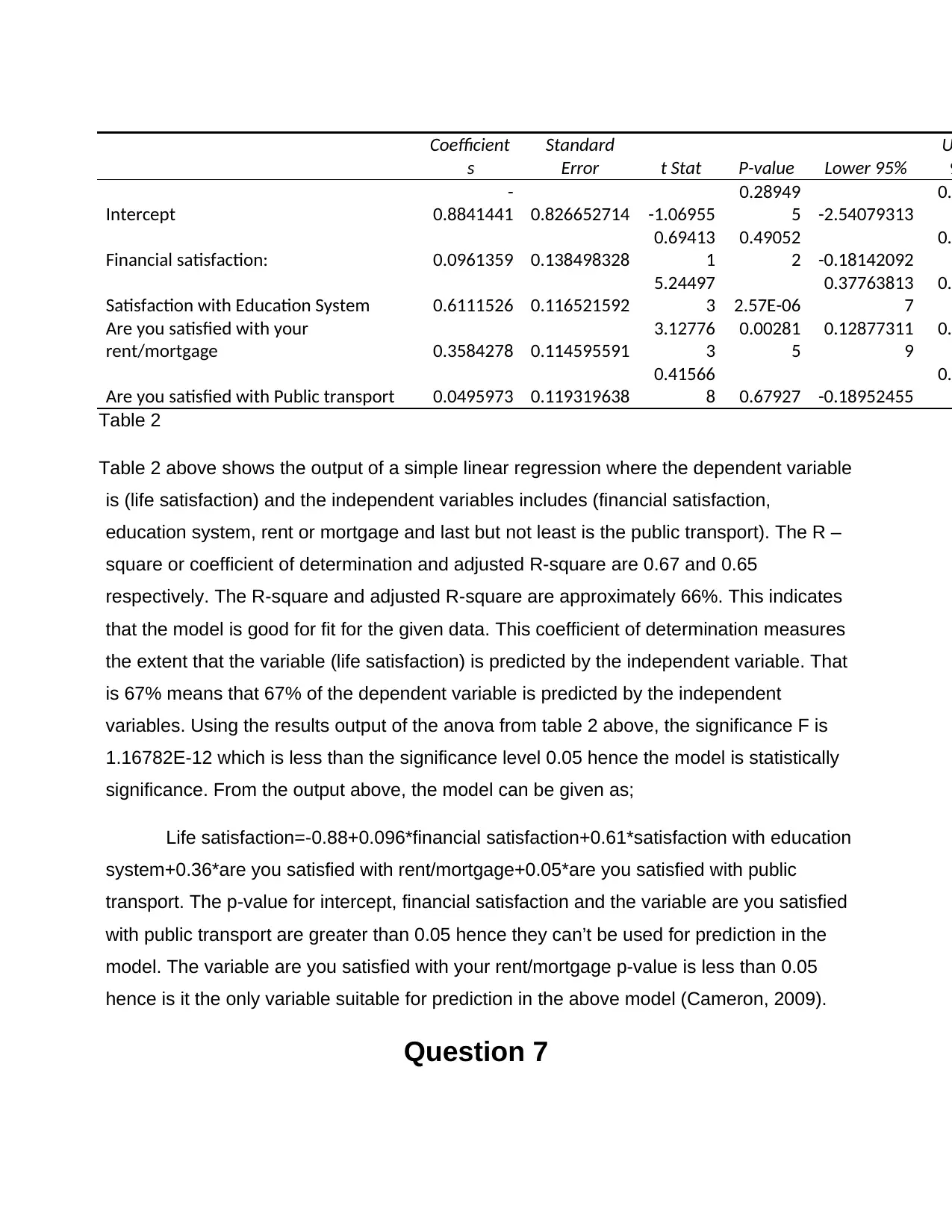
Coefficient
s
Standard
Error t Stat P-value Lower 95%
U
9
Intercept
-
0.8841441 0.826652714 -1.06955
0.28949
5 -2.54079313
0.7
Financial satisfaction: 0.0961359 0.138498328
0.69413
1
0.49052
2 -0.18142092
0.3
Satisfaction with Education System 0.6111526 0.116521592
5.24497
3 2.57E-06
0.37763813
7
0.8
Are you satisfied with your
rent/mortgage 0.3584278 0.114595591
3.12776
3
0.00281
5
0.12877311
9
0.5
Are you satisfied with Public transport 0.0495973 0.119319638
0.41566
8 0.67927 -0.18952455
0.2
Table 2
Table 2 above shows the output of a simple linear regression where the dependent variable
is (life satisfaction) and the independent variables includes (financial satisfaction,
education system, rent or mortgage and last but not least is the public transport). The R –
square or coefficient of determination and adjusted R-square are 0.67 and 0.65
respectively. The R-square and adjusted R-square are approximately 66%. This indicates
that the model is good for fit for the given data. This coefficient of determination measures
the extent that the variable (life satisfaction) is predicted by the independent variable. That
is 67% means that 67% of the dependent variable is predicted by the independent
variables. Using the results output of the anova from table 2 above, the significance F is
1.16782E-12 which is less than the significance level 0.05 hence the model is statistically
significance. From the output above, the model can be given as;
Life satisfaction=-0.88+0.096*financial satisfaction+0.61*satisfaction with education
system+0.36*are you satisfied with rent/mortgage+0.05*are you satisfied with public
transport. The p-value for intercept, financial satisfaction and the variable are you satisfied
with public transport are greater than 0.05 hence they can’t be used for prediction in the
model. The variable are you satisfied with your rent/mortgage p-value is less than 0.05
hence is it the only variable suitable for prediction in the above model (Cameron, 2009).
Question 7
s
Standard
Error t Stat P-value Lower 95%
U
9
Intercept
-
0.8841441 0.826652714 -1.06955
0.28949
5 -2.54079313
0.7
Financial satisfaction: 0.0961359 0.138498328
0.69413
1
0.49052
2 -0.18142092
0.3
Satisfaction with Education System 0.6111526 0.116521592
5.24497
3 2.57E-06
0.37763813
7
0.8
Are you satisfied with your
rent/mortgage 0.3584278 0.114595591
3.12776
3
0.00281
5
0.12877311
9
0.5
Are you satisfied with Public transport 0.0495973 0.119319638
0.41566
8 0.67927 -0.18952455
0.2
Table 2
Table 2 above shows the output of a simple linear regression where the dependent variable
is (life satisfaction) and the independent variables includes (financial satisfaction,
education system, rent or mortgage and last but not least is the public transport). The R –
square or coefficient of determination and adjusted R-square are 0.67 and 0.65
respectively. The R-square and adjusted R-square are approximately 66%. This indicates
that the model is good for fit for the given data. This coefficient of determination measures
the extent that the variable (life satisfaction) is predicted by the independent variable. That
is 67% means that 67% of the dependent variable is predicted by the independent
variables. Using the results output of the anova from table 2 above, the significance F is
1.16782E-12 which is less than the significance level 0.05 hence the model is statistically
significance. From the output above, the model can be given as;
Life satisfaction=-0.88+0.096*financial satisfaction+0.61*satisfaction with education
system+0.36*are you satisfied with rent/mortgage+0.05*are you satisfied with public
transport. The p-value for intercept, financial satisfaction and the variable are you satisfied
with public transport are greater than 0.05 hence they can’t be used for prediction in the
model. The variable are you satisfied with your rent/mortgage p-value is less than 0.05
hence is it the only variable suitable for prediction in the above model (Cameron, 2009).
Question 7
⊘ This is a preview!⊘
Do you want full access?
Subscribe today to unlock all pages.

Trusted by 1+ million students worldwide
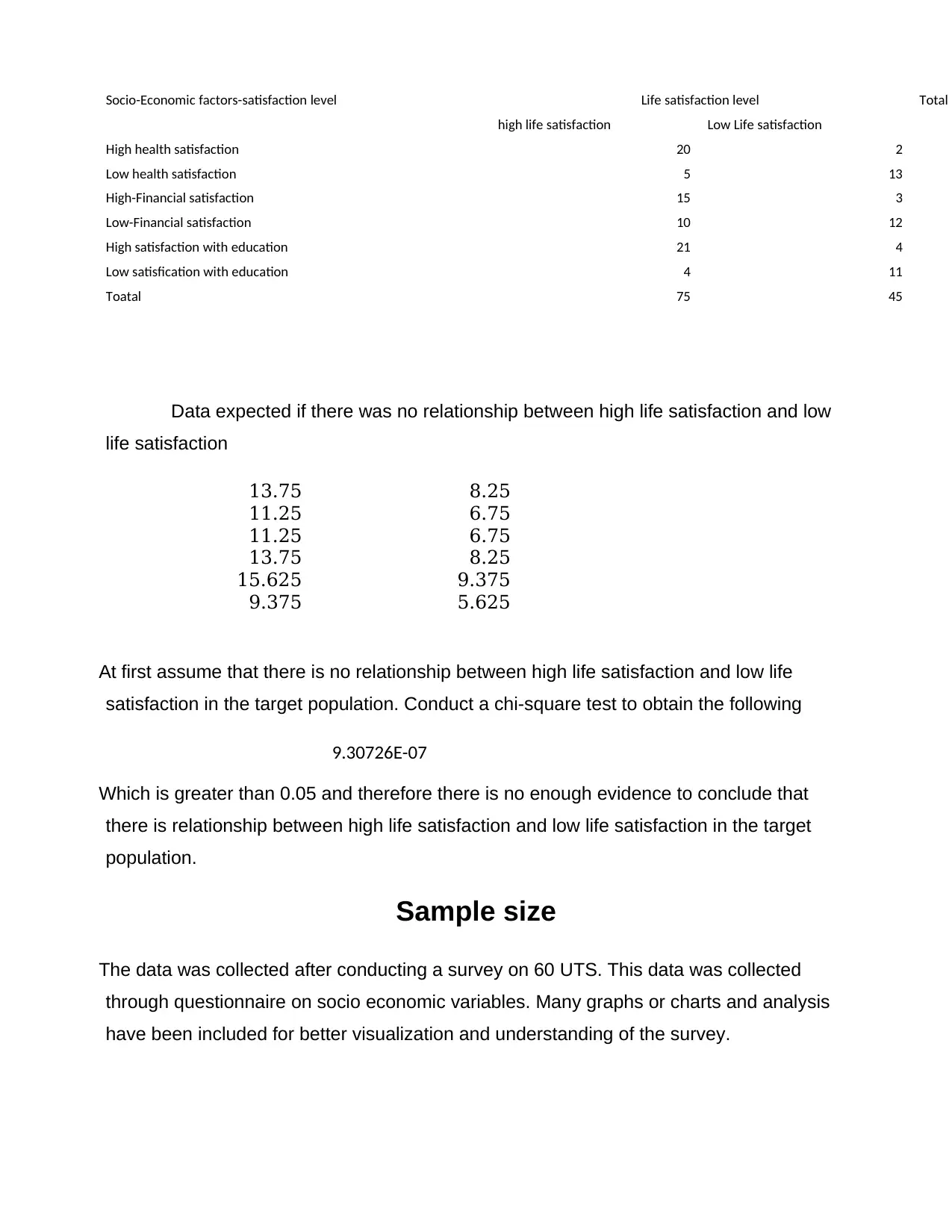
Socio-Economic factors-satisfaction level Life satisfaction level Total
high life satisfaction Low Life satisfaction
High health satisfaction 20 2
Low health satisfaction 5 13
High-Financial satisfaction 15 3
Low-Financial satisfaction 10 12
High satisfaction with education 21 4
Low satisfication with education 4 11
Toatal 75 45
Data expected if there was no relationship between high life satisfaction and low
life satisfaction
13.75 8.25
11.25 6.75
11.25 6.75
13.75 8.25
15.625 9.375
9.375 5.625
At first assume that there is no relationship between high life satisfaction and low life
satisfaction in the target population. Conduct a chi-square test to obtain the following
9.30726E-07
Which is greater than 0.05 and therefore there is no enough evidence to conclude that
there is relationship between high life satisfaction and low life satisfaction in the target
population.
Sample size
The data was collected after conducting a survey on 60 UTS. This data was collected
through questionnaire on socio economic variables. Many graphs or charts and analysis
have been included for better visualization and understanding of the survey.
high life satisfaction Low Life satisfaction
High health satisfaction 20 2
Low health satisfaction 5 13
High-Financial satisfaction 15 3
Low-Financial satisfaction 10 12
High satisfaction with education 21 4
Low satisfication with education 4 11
Toatal 75 45
Data expected if there was no relationship between high life satisfaction and low
life satisfaction
13.75 8.25
11.25 6.75
11.25 6.75
13.75 8.25
15.625 9.375
9.375 5.625
At first assume that there is no relationship between high life satisfaction and low life
satisfaction in the target population. Conduct a chi-square test to obtain the following
9.30726E-07
Which is greater than 0.05 and therefore there is no enough evidence to conclude that
there is relationship between high life satisfaction and low life satisfaction in the target
population.
Sample size
The data was collected after conducting a survey on 60 UTS. This data was collected
through questionnaire on socio economic variables. Many graphs or charts and analysis
have been included for better visualization and understanding of the survey.
Paraphrase This Document
Need a fresh take? Get an instant paraphrase of this document with our AI Paraphraser

Reference
Cameron, Colin. 2009. "EXCEL Multiple Regression". Cameron.Econ.Ucdavis.Edu.
http://cameron.econ.ucdavis.edu/excel/ex61multipleregression.html.
Cameron, Colin. 2009. "EXCEL Multiple Regression". Cameron.Econ.Ucdavis.Edu.
http://cameron.econ.ucdavis.edu/excel/ex61multipleregression.html.
1 out of 8
Related Documents
Your All-in-One AI-Powered Toolkit for Academic Success.
+13062052269
info@desklib.com
Available 24*7 on WhatsApp / Email
![[object Object]](/_next/static/media/star-bottom.7253800d.svg)
Unlock your academic potential
Copyright © 2020–2025 A2Z Services. All Rights Reserved. Developed and managed by ZUCOL.




